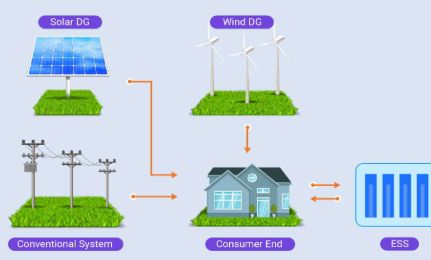Decentralized Solar Swarm: A Revolutionary Approach to Smart Microgrid Systems
Introduction
The world is rapidly transitioning to renewable energy sources, with solar power emerging as one of the most viable options. However, traditional centralized solar energy distribution has limitations such as transmission losses and vulnerability to grid failures. The concept of a Decentralized Solar Swarm presents a groundbreaking approach to solving these issues. By leveraging interconnected microgrids that communicate and share energy, this system enhances efficiency, resilience, and accessibility. This article explores the fundamental aspects of decentralized solar swarms, their advantages, challenges, and real-world applications.
Understanding Decentralized Solar Swarm
A decentralized solar swarm consists of multiple small solar microgrids interconnected to form a network that dynamically manages energy distribution. Unlike traditional centralized grids, where a single power source supplies energy to multiple locations, a swarm-based system operates on a peer-to-peer model. Each microgrid can produce, store, and share excess energy with neighboring grids, creating a self-sustaining and resilient energy ecosystem.
The concept is inspired by biological swarms, such as bee colonies or ant networks, where individuals work collaboratively to achieve a common goal. Similarly, in a solar swarm, smart algorithms and real-time data analytics enable grids to optimize energy flow and balance supply and demand efficiently.
Key Advantages of a Solar Swarm System
1. Enhanced Grid Resilience and Reliability
One of the primary benefits of a decentralized solar swarm is its ability to withstand disruptions. Traditional power grids are vulnerable to large-scale blackouts due to centralized failure points. However, a decentralized microgrid network distributes energy sources, minimizing the risk of complete power loss. In the event of a local outage, neighboring microgrids can reroute energy, ensuring continuous power supply.
2. Improved Energy Efficiency
Transmission losses occur when electricity travels long distances from centralized power plants to end users. A decentralized system reduces these losses by generating power closer to the consumption point. This localized approach ensures maximum utilization of generated solar energy while reducing dependency on fossil fuel-based backup systems.
3. Economic and Environmental Benefits
Decentralized solar swarms promote sustainability by reducing greenhouse gas emissions and lowering reliance on non-renewable energy sources. Additionally, they can significantly reduce electricity costs for consumers by enabling peer-to-peer energy trading, where excess energy can be sold to neighbors instead of being wasted.
4. Scalability and Flexibility
Unlike large power plants that require extensive infrastructure, decentralized solar microgrids can be deployed in a modular manner. Communities can start with a small system and expand as energy demands grow. This flexibility makes solar swarms an ideal solution for remote and off-grid locations where traditional electricity infrastructure is impractical.
Challenges and Solutions in Implementing Solar Swarms
1. Initial High Costs
The upfront investment required for setting up decentralized solar microgrids, including solar panels, battery storage, and smart grid technology, can be high. However, declining costs of solar technology and increasing government incentives are making it more affordable. Additionally, community-based investment models and microfinancing can help overcome financial barriers.
2. Energy Storage and Distribution
Effective energy storage is crucial for a reliable solar swarm system. While battery technology is improving, challenges remain in ensuring long-term efficiency and affordability. Innovative solutions such as hybrid storage systems and AI-driven energy management can enhance the performance of decentralized grids.
3. Regulatory and Policy Barriers
Many energy markets are structured around centralized utilities, creating regulatory obstacles for decentralized solar networks. To address this, governments need to update policies to support peer-to-peer energy trading, grid interconnection, and incentives for decentralized renewable systems.
Real-World Applications of Solar Swarm Technology
1. Rural Electrification
Many remote and underserved regions lack access to reliable electricity. Decentralized solar swarms provide an affordable and scalable solution for electrifying these areas without the need for extensive infrastructure investments.
2. Smart Cities and Urban Energy Management
In urban settings, solar swarms can enhance the efficiency of smart city projects by integrating renewable energy sources with IoT-based grid management. This reduces reliance on fossil fuels and promotes sustainable urban development.
3. Disaster Recovery and Emergency Energy Supply
During natural disasters, centralized power grids often fail, leaving affected communities without electricity. Decentralized microgrids can provide an emergency energy supply, ensuring critical services such as hospitals, water supply, and communication systems remain operational.
Future Outlook of Decentralized Solar Swarms
As technology advances, decentralized solar swarms will become an integral part of global energy systems. Innovations in AI-driven grid management, improved battery storage, and supportive regulatory frameworks will accelerate the adoption of this revolutionary approach. With continued investment and policy support, solar swarms have the potential to reshape the energy landscape, making renewable power more accessible, affordable, and resilient.
Conclusion
The Decentralized Solar Swarm represents a transformative shift in energy distribution, offering a smarter, more efficient, and resilient alternative to traditional power grids. By leveraging interconnected microgrids, communities can achieve energy independence, reduce environmental impact, and create sustainable energy ecosystems. While challenges exist, advancements in technology and supportive policies will drive widespread adoption. Embracing this innovative approach will be key to a cleaner, more sustainable future for global energy systems.


Leave a Comment